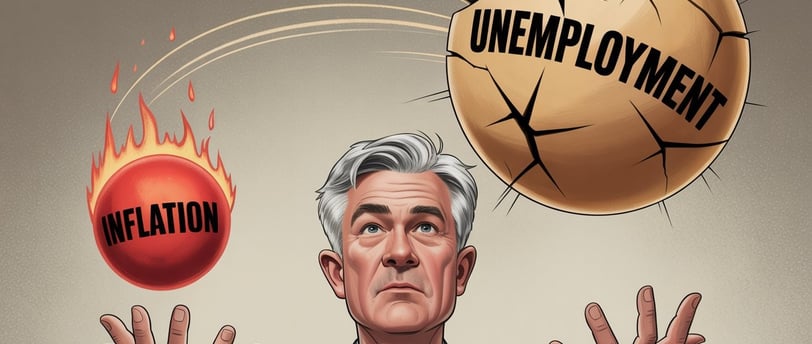Crypto Analysis: Negative GDP, Sticky Inflation, and BTC in a Downtrend Channel. What Does the Weekly Data Tell Us?
The week was filled with important economic data that brought a mixed message to the markets. We saw signs of a slowdown, inflation that continues to bother the Federal Reserve, and a Bitcoin that, despite its attempts, is still struggling to break its downtrend. But what do these numbers really mean for your portfolio?
6/30/20253 min read


Crypto Analysis: Negative GDP, Sticky Inflation, and BTC in a Downtrend Channel. What Does the Weekly Data Tell Us?
The week was filled with important economic data that brought a mixed message to the markets. We saw signs of a slowdown, inflation that continues to bother the Federal Reserve, and a Bitcoin that, despite its attempts, is still struggling to break its downtrend. But what do these numbers really mean for your portfolio?
In this quick and direct analysis, we'll summarize the main results of the week, the Fed's likely stance going forward, and what technical analysis shows us about the current state of Bitcoin and altcoins.
X-Ray of Economic Data: The Mixed US Scenario
The week brought data pointing in different directions, creating an environment of uncertainty.
Negative GDP and Unemployment: Signs of a Slowdown
US GDP: Came in worse than expected, with a contraction of -0.5%, against a projection of -0.2%. This is a clear sign of the economic slowdown we have been anticipating.
Jobless Claims: On the other hand, initial claims were better than expected (236k vs. 244k projected), showing some resilience in the short-term labor market.
PCE Inflation Above Expectations: The Fed's Headache
The data that weighed the most was inflation. The PCE, the Fed's preferred indicator, came in at 2.7%, slightly above the expected 2.6%. This figure reinforces Jerome Powell's narrative that inflation, possibly driven by tariffs, is still a concern. Leading indicators like Trueflation also show a slight upward trend, giving the Fed the perfect argument to maintain its cautious stance.
Positive News: US-China Tariffs and the Use of BTC as Collateral
Amidst the mixed data, two positive news items stood out:
China confirmed an improvement in trade relations with the US, with expectations that the friendly tone will extend to other countries in July.
A US federal agency began allowing the use of Bitcoin as collateral for real estate financing, without the need to convert to fiat currency, which represents a significant step forward in the asset's usability.
Bitcoin's Battle: Trapped in a Downtrend Channel
Despite testing the $107-108k levels, technically, Bitcoin remains within a downtrend channel.
Technical Analysis: Why Does BTC Need to Break Resistance?
Until the price gathers enough strength to break the upper trendline of this channel and sustain itself above it, the probability is that it will continue to trade sideways or downwards, as we have warned since early May. Renewing the all-time high is crucial to confirm the resumption of the uptrend.
Altcoins and Dominance: Weakness Persists
The scenario for altcoins is even more delicate. The index measuring the strength of altcoins against Bitcoin continues to fall, and BTC dominance remains high. This indicates that, for now, capital is not flowing into smaller-cap assets, and profits in altcoins should be managed with caution.
What to Expect from the Fed? September in Focus and the Unemployment Trigger
With inflation still "hot," expectations of a rate cut in July are drastically diminishing.
The End of QT is More Important Than Rate Cuts
The most realistic and "down-to-earth" perspective is that the Fed will only consider a rate cut in September. However, more important than a small 0.25% cut is the end of Quantitative Tightening (QT). The market needs more liquidity, and the end of quantitative tightening, also expected for the end of the third quarter, is the most anticipated event.
The Summer of Liquidity and Vigilance over the Labor Market
We continue with the outlook of a summer with lower liquidity, with the Fed possibly trying to rebuild its tools (like the TGA). The major trigger for a change in the Fed's stance, as previously mentioned, will be the unemployment rate. If labor market data worsens significantly in the coming months, Jerome Powell will be forced to act more quickly to stimulate the economy, regardless of inflation.
Conclusion: Navigating a Sideways Market with an Eye on the Coming Months
In summary: the macroeconomic data is mixed, the Fed is expected to be on hold until September, and Bitcoin is at a decisive technical point, needing to break its downtrend channel. The general scenario is one of sideways movement and maximum attention over the next few months.
The main thesis remains: inflation is the narrative, but unemployment is the trigger. The proximity of the end of the cycle demands caution, strategy, and a focus on fundamentals to avoid getting lost in the day-to-day noise. Be prepared for a summer of consolidation, keeping an eye on the catalysts that could define the final stretch of 2025.
